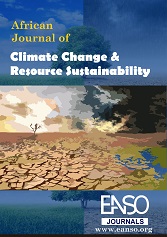Assessment of the Impacts of Climate Variability on Surface Water Quality of Nyabarongo River, Rwanda
Ikisiri
The study aimed to investigate the impact of climatic variability on the surface water quality of the Nyabarongo River over the 2019 – 2024 period. The research sought to identify how seasonal changes in rainfall and temperature influence various physicochemical and microbial water quality parameters. Key findings revealed significant seasonal variations in water quality, closely linked to climatic factors. During the rainy seasons, water quality parameters such as nitrate and total coliform counts were notably elevated. For example, average nitrate concentrations were highest during these periods, reaching 132.39 mg/L in March-April-May and 77.33 mg/L in January-February, compared to much lower levels of 15.41 mg/L in June-July-August. Similarly, total coliform counts peaked at 189,597.22 MPN/100 mL in March-April-May and 164,799.08 MPN/100 mL in January-February, while they dropped to 65,537.11 MPN/100 mL in June-July-August. This pattern suggested that increased rainfall leads to higher runoff and potential contamination sources entering the river, adversely affecting microbial water quality. Temperature also played a role in influencing water quality, albeit less dramatically than rainfall. The study noted relatively stable temperature ranges across the seasons, but with slight variations that could affect biological activity in the water. Overall, the findings underscore a clear relationship between climatic variability, specifically rainfall patterns, and the surface water quality of the Nyabarongo River, indicating that periods of heavy rainfall can lead to deteriorating water quality due to increased nutrient loading and contamination. This study recommended the need for effective water quality management strategies, particularly during the rainy season when the river is more susceptible to pollution
Upakuaji
Marejeleo
Ahmed, M., Hamed, R., International, C., Cic, C., & Zayed, E. S. (2023). The Impact of Climate Change on The Surface Water Quality of Drinking Water Treatment Plants in Egypt. p 42, 181–187.
Alahacoon, N., Edirisinghe, M., Simwanda, M., Perera, E. N. C., Nyirenda, V. R., & Ranagalage, M. (2022). Rainfall variability and trends over the African continent using tamsat data (1983–2020): Towards climate change resilience and adaptation. Remote Sensing, 14(1), 1–26. https://doi.org/10.3390/rs14010096
Amit, R., Dilip, K., & Bhishm, S. K. (2024). A review on climate change impacts, models, and its consequences on different sectors: a systematic approach. Journal of Water and Climate Change, 15(1), 104–126. https://doi.org/10.2166/wcc.2023.536
Bates, B., Kundzewicz, Z. W., Shaohong, W., & Palutikof, J. (2008). Climate Change and Water. Technical Paper of the Intergovernmental Panel on Climate Change, IPCC Secretariat. In Climate Change and Water Resources (Issue June). https://doi.org/10.1201/b16969
El-Jabi, N., Caissie, D., & Turkkan, N. (2014). Water Quality Index Assessment under Climate Change. Journal of Water Resource and Protection, 06(06), 533–542. https://doi.org/10.4236/jwarp.2014.66052
Francis Wasswa, N. N., Dr. Jane, M. O., & Dr. Daniel, D. (2013). Climate Variability And Its Implication For Water Resources And Livelihoods In Uganda. 1969(9017), 9–10.
Gunes, G. (2022). The change of metal pollution in the water and sediment of the Bartın River in rainy and dry seasons. Environmental Engineering Research, 27(2), 0– 2. https://doi.org/10.4491/eer.2020.701
Klasic, M., Ekstrom, J., Lubell, M., & Bedsworth, L. (2017). Water Quality and Extreme Events in the Face of Climate Change: Does science supply meet demand? XVI World Water Congress, 29.
Kundzewicz, Z. W. (2008). Climate change impacts on the hydrological cycle. Ecohydrology and Hydrobiology, 8(2–4), 195–203. https://doi.org/10.2478/v10104-009-0015-y
Manikuze, P., & Nyongesah, J. (2023). Vulnerability of Nyabarongo River Water Abstraction to Climate Change in Rwanda. International Journal of Environmental Sciences, 6(2), 1–14. https://doi.org/10.47604/ijes.1775
Maranguit, D., Guillaume, T., & Kuzyakov, Y. (2017). Effects of flooding on phosphorus and iron mobilization in highly weathered soils under different land-use types: Short-term effects and mechanisms. Catena, 158(March), 161–170. https://doi.org/10.1016/j.catena.2017.06.023
Nguyen, T., & Lee, T. (2020). Impact of Climate Variability on Water Resources. Journal of Climate Studies, 22(1), 77–91.
RoR, R. of R. (2018). Upper Nyabarongo Catchment Management Plan (2018-2014). Republic of Rwanda/ Ministry of Environments, 1–317.
Singh, S. K., Subramanian, V., & Gibbs, R. J. (1900). Volume 14, Issue 1 33 HYDROUS FE AND MN OXIDES-SCAVENGERS OF HEAVY METALS IN THE AQUATIC ENVIRONMENT. 14(1).
Sonone, S. S., Jadhav, S., Sankhla, M. S., & Kumar, R. (2021). Water Contamination by Heavy Metals and their Toxic Effect on Aquaculture and Human Health through Food Chain. Letters in Applied NanoBioScience, 10(2), 2148– 2166. https://doi.org/10.33263/LIANBS102.21482166
Tae Kyun Kim. (2017). Understanding one-way anova using conceptual figures. Korean Journal of Anesthesiology, 70(1), 22–26.
Thornton, P. K., Ericksen, P. J., Herrero, M., & Challinor, A. J. (2014). Climate variability and vulnerability to climate change: A review. Global Change Biology, 20(11), 3313–3328. https://doi.org/10.1111/gcb.12581
Wayne, G., & Wendy, A. I. (2016). Climate change impacts on surface water quality. Environmental Sustainability and Climate Change Adaptation Strategies, January, 322–340. https://doi.org/10.4018/978-1-5225-1607-1.ch012
Copyright (c) 2025 Justine Mutoni, Christophe Mupenzi, PhD

This work is licensed under a Creative Commons Attribution 4.0 International License.




























